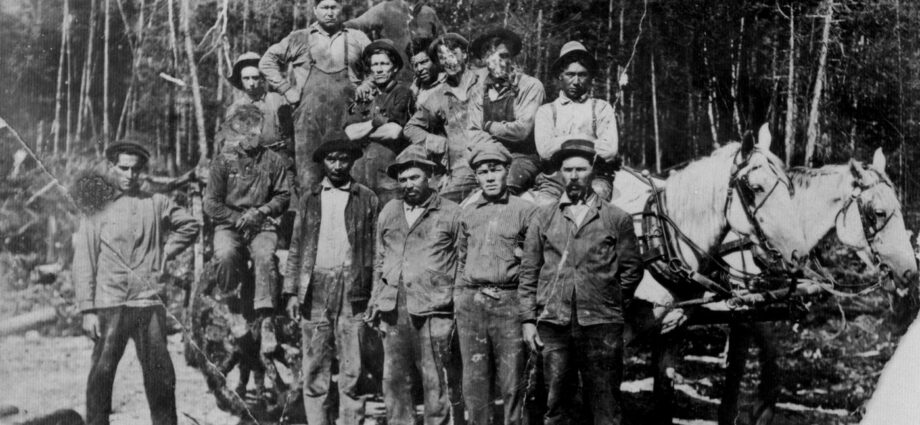
By Story told by: Kevin Ka’nahsóhon Deer, Written by: Marcus Bankuti – Local Journalism Initiative Reporter, Translation by: Sahawisó:ko’ Arquette, Photos: Courtesy Kanien’keháka Onkwawén:na Raotitióhkwa Language and Cultural Center archive, The Eastern Door
January 30, 2023
When I came into the world in 1957, Kahnawake had already gone through a lot of changes compared to my mom’s time. Back then, everybody spoke Mohawk. In my grandmother’s time, almost everybody spoke 3 languages. Everybody in my grandparents’ time all spoke Mohawk. It was odd if anybody didn’t speak it. The peddlers who would come to the reserve, they learned the language, enough to buy and sell or trade. So it didn’t take long – in less than 100 years – we almost lost it.
As a little boy growing up, even though both my parents were fluent speakers, they didn’t teach us, because the prevailing attitude was you don’t need Mohawk to get an education and job. I guess because of TV, radio, telephone, and electricity coming into the community, and all of that hype, in the early 30s and 40s, it impacted how we communicated with one another, and English began to prevail.
It’s interesting. My mother had 12 siblings. One half, they’re all fluent speakers, and one half, they’re not speakers. When I asked, they said that’s what it was. It seems that when they ended up getting electricity, then the radio came in and then the TV, so that was kind of the thing that started where the language went in decline. Then because of the experience of them going through school, and Mohawk language is not a priority. It just wasn’t. And at times forbidden to be spoken. At that time Kahnawake was a so-called christian community.
*
Sha’kenákerate’ kí:ken kèn:tho tsi ionhontsá:te 1957 shiiohserò:ten’, é:so ó:nen teiotteniónkwen Kahnawà:ke tsi ní:ioht ne ake’nisténha shontaiakotehiahróntie’. Tho shikahá:wi, tsi’k ónhka ionhrónkha’ Kanien’kéha. Tsi ní:ioht tsi iakotenhniseraténionhkwe’ ne akhsothkénha thóha akwé:kon áhsen nihatiwennakéhne’. Ionkhsothokón:ha ken’ shithotiién:ha akwé:kon Kanien’kéha rontá:tiskwe’. Tsi niká:ien rontkè:rons aontahòn:ne’ tsi kanonhstá:ton, wahontewennaweientéhta’ne’, ia’tekaié:ri ne nahitihní:non’ tánon’ ahontenhní:non’ tóka’ ni’ tahontá:ton’. Iah teiorihweshà:’on – ká:ron 100 niiohserá:ke seréka aionkwatewennahtón:ni.
Shikeksà:’a shontonkwatehiahróntie’, tehnitsá:ron iontièn:’a sá:ne ieniwennaieríhahkwe’, iah teionkhirihonnién:ni, ase’kén é:so rá:ti tho nihoti’nikonhro’ténhne’ tsi iah tha’teiotonhontsóhon Kanien’kéha ahsà:ronke’ ahsatéweienste’ nok aiesaio’tenhseraién:ta’ne’. Khé:re tsi eh nontà:we’ tsi tká:ra’s, waterennótha’, iontewennata’áhstha’, nok ken’tonhkarà:ken onkwanakerahserá:kon taiotike’tohtonhátiehkwe’. É:so rá:ti nè:’e tahoti’nikonhratihéntho’ 1930 shiiohseratátie’ tánon’ shiiotahsawátiene’ 1940 shiiohseratátie’, wa’tkaté:ni’ tsi na’teiakwátere tsi ní:tsi teiakwahtháhrha’ , tánon’ Tiohrhèn:sha tontáhsawen’ aontkwé:ni’ aonsaiakwatá:ti’.
Tio’nikonhratihénthoht. Ake’nisténha 12 iako’kenhshén:tahkwe’. Sha’tekanenhrí:hen akwé:kon iehatiwennaié:ri, nok ne ronátia’ke iah tehontá:ti. Sha’keri’wanón:ton’, wahonnì:ron’ nek ki’ tho ní:ioht. Á:ienhre’k shahotiién:ta’ne’ ne ken’tonhkwarà:ken tánon’ waterennótha’ sok ki’ tká:ra’s ó:ni’ taiotikè:tohte’, tho ki’ nón: ní:tsi tiotáhsawe aontewennáhton’. Sok tsi thonaterihwaiensta’nónhne’, iah teiorihowá:nen ne Kanien’kéha owén:na. Iah ki’k tho té:ioht. Tánon’ sewatié:rens watiawén:re aiontá:ti’. Tho shikahá:wi ratina’tónhkhwahkwe’ Kahnawà:ke tsi Tehatiiahsóntha’ tsi nikanakerahserò:ten’
Subscribe to our newsletter.

